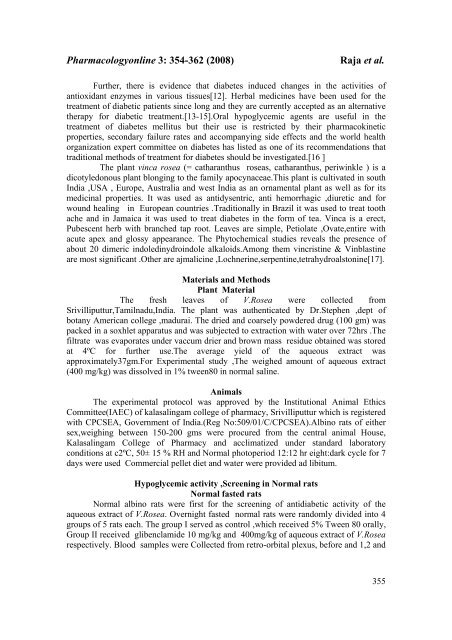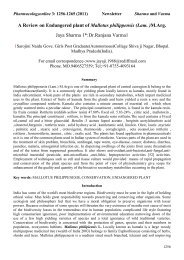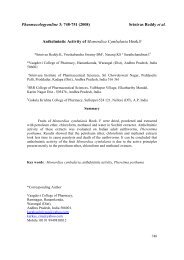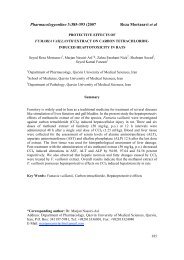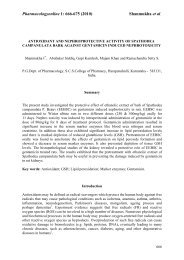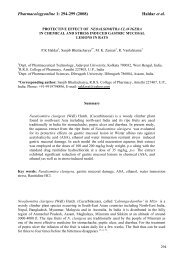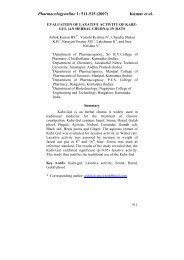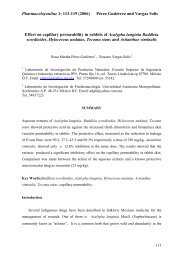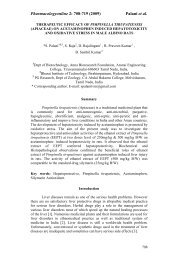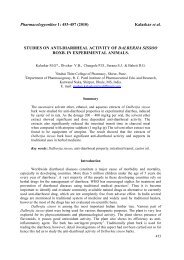Antihyperglycaemic Activity of Aqueous Extract of Vinca Rosea Linn ...
Antihyperglycaemic Activity of Aqueous Extract of Vinca Rosea Linn ...
Antihyperglycaemic Activity of Aqueous Extract of Vinca Rosea Linn ...
Create successful ePaper yourself
Turn your PDF publications into a flip-book with our unique Google optimized e-Paper software.
Pharmacologyonline 3: 354-362 (2008) Raja et al.<br />
Further, there is evidence that diabetes induced changes in the activities <strong>of</strong><br />
antioxidant enzymes in various tissues[12]. Herbal medicines have been used for the<br />
treatment <strong>of</strong> diabetic patients since long and they are currently accepted as an alternative<br />
therapy for diabetic treatment.[13-15].Oral hypoglycemic agents are useful in the<br />
treatment <strong>of</strong> diabetes mellitus but their use is restricted by their pharmacokinetic<br />
properties, secondary failure rates and accompanying side effects and the world health<br />
organization expert committee on diabetes has listed as one <strong>of</strong> its recommendations that<br />
traditional methods <strong>of</strong> treatment for diabetes should be investigated.[16 ]<br />
The plant vinca rosea (= catharanthus roseas, catharanthus, periwinkle ) is a<br />
dicotyledonous plant blonging to the family apocynaceae.This plant is cultivated in south<br />
India ,USA , Europe, Australia and west India as an ornamental plant as well as for its<br />
medicinal properties. It was used as antidysentric, anti hemorrhagic ,diuretic and for<br />
wound healing in European countries .Traditionally in Brazil it was used to treat tooth<br />
ache and in Jamaica it was used to treat diabetes in the form <strong>of</strong> tea. <strong>Vinca</strong> is a erect,<br />
Pubescent herb with branched tap root. Leaves are simple, Petiolate ,Ovate,entire with<br />
acute apex and glossy appearance. The Phytochemical studies reveals the presence <strong>of</strong><br />
about 20 dimeric indoledinydroindole alkaloids.Among them vincristine & Vinblastine<br />
are most significant .Other are ajmalicine ,Lochnerine,serpentine,tetrahydroalstonine[17].<br />
Materials and Methods<br />
Plant Material<br />
The fresh leaves <strong>of</strong> V.<strong>Rosea</strong> were collected from<br />
Srivilliputtur,Tamilnadu,India. The plant was authenticated by Dr.Stephen ,dept <strong>of</strong><br />
botany American college ,madurai. The dried and coarsely powdered drug (100 gm) was<br />
packed in a soxhlet apparatus and was subjected to extraction with water over 72hrs .The<br />
filtrate was evaporates under vaccum drier and brown mass residue obtained was stored<br />
at 4ºC for further use.The average yield <strong>of</strong> the aqueous extract was<br />
approximately37gm.For Experimental study ,The weighed amount <strong>of</strong> aqueous extract<br />
(400 mg/kg) was dissolved in 1% tween80 in normal saline.<br />
Animals<br />
The experimental protocol was approved by the Institutional Animal Ethics<br />
Committee(IAEC) <strong>of</strong> kalasalingam college <strong>of</strong> pharmacy, Srivilliputtur which is registered<br />
with CPCSEA, Government <strong>of</strong> India.(Reg No:509/01/C/CPCSEA).Albino rats <strong>of</strong> either<br />
sex,weighing between 150-200 gms were procured from the central animal House,<br />
Kalasalingam College <strong>of</strong> Pharmacy and acclimatized under standard laboratory<br />
conditions at c2ºC, 50± 15 % RH and Normal photoperiod 12:12 hr eight:dark cycle for 7<br />
days were used Commercial pellet diet and water were provided ad libitum.<br />
Hypoglycemic activity ,Screening in Normal rats<br />
Normal fasted rats<br />
Normal albino rats were first for the screening <strong>of</strong> antidiabetic activity <strong>of</strong> the<br />
aqueous extract <strong>of</strong> V.<strong>Rosea</strong>. Overnight fasted normal rats were randomly divided into 4<br />
groups <strong>of</strong> 5 rats each. The group I served as control ,which received 5% Tween 80 orally,<br />
Group II received glibenclamide 10 mg/kg and 400mg/kg <strong>of</strong> aqueous extract <strong>of</strong> V.<strong>Rosea</strong><br />
respectively. Blood samples were Collected from retro-orbital plexus, before and 1,2 and<br />
355


